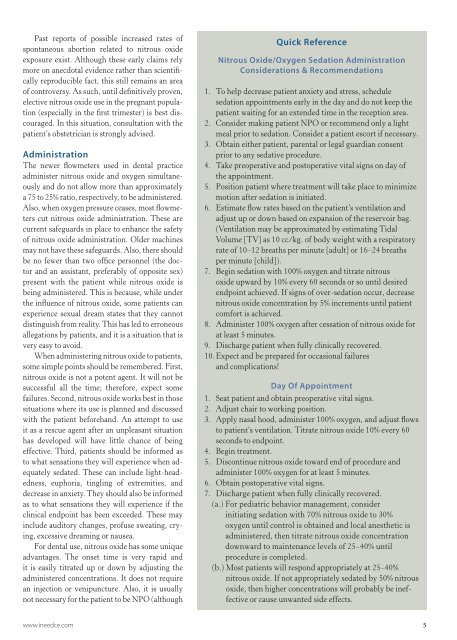Nitrous Oxide, From Discovery to Now - IneedCE.com
Nitrous Oxide, From Discovery to Now - IneedCE.com
Nitrous Oxide, From Discovery to Now - IneedCE.com
Create successful ePaper yourself
Turn your PDF publications into a flip-book with our unique Google optimized e-Paper software.
Past reports of possible increased rates of<br />
spontaneous abortion related <strong>to</strong> nitrous oxide<br />
exposure exist. Although these early claims rely<br />
more on anecdotal evidence rather than scientifically<br />
reproducible fact, this still remains an area<br />
of controversy. As such, until definitively proven,<br />
elective nitrous oxide use in the pregnant population<br />
(especially in the first trimester) is best discouraged.<br />
In this situation, consultation with the<br />
patient’s obstetrician is strongly advised.<br />
Administration<br />
The newer flowmeters used in dental practice<br />
administer nitrous oxide and oxygen simultaneously<br />
and do not allow more than approximately<br />
a 75 <strong>to</strong> 25% ratio, respectively, <strong>to</strong> be administered.<br />
Also, when oxygen pressure ceases, most flowmeters<br />
cut nitrous oxide administration. These are<br />
current safeguards in place <strong>to</strong> enhance the safety<br />
of nitrous oxide administration. Older machines<br />
may not have these safeguards. Also, there should<br />
be no fewer than two office personnel (the doc<strong>to</strong>r<br />
and an assistant, preferably of opposite sex)<br />
present with the patient while nitrous oxide is<br />
being administered. This is because, while under<br />
the influence of nitrous oxide, some patients can<br />
experience sexual dream states that they cannot<br />
distinguish from reality. This has led <strong>to</strong> erroneous<br />
allegations by patients, and it is a situation that is<br />
very easy <strong>to</strong> avoid.<br />
When administering nitrous oxide <strong>to</strong> patients,<br />
some simple points should be remembered. First,<br />
nitrous oxide is not a potent agent. It will not be<br />
successful all the time; therefore, expect some<br />
failures. Second, nitrous oxide works best in those<br />
situations where its use is planned and discussed<br />
with the patient beforehand. An attempt <strong>to</strong> use<br />
it as a rescue agent after an unpleasant situation<br />
has developed will have little chance of being<br />
effective. Third, patients should be informed as<br />
<strong>to</strong> what sensations they will experience when adequately<br />
sedated. These can include light-headedness,<br />
euphoria, tingling of extremities, and<br />
decrease in anxiety. They should also be informed<br />
as <strong>to</strong> what sensations they will experience if the<br />
clinical endpoint has been exceeded. These may<br />
include audi<strong>to</strong>ry changes, profuse sweating, crying,<br />
excessive dreaming or nausea.<br />
For dental use, nitrous oxide has some unique<br />
advantages. The onset time is very rapid and<br />
it is easily titrated up or down by adjusting the<br />
administered concentrations. It does not require<br />
an injection or venipuncture. Also, it is usually<br />
not necessary for the patient <strong>to</strong> be NPO (although<br />
Quick Reference<br />
<strong>Nitrous</strong> <strong>Oxide</strong>/Oxygen Sedation Administration<br />
Considerations & Re<strong>com</strong>mendations<br />
1. To help decrease patient anxiety and stress, schedule<br />
sedation appointments early in the day and do not keep the<br />
patient waiting for an extended time in the reception area.<br />
2. Consider making patient NPO or re<strong>com</strong>mend only a light<br />
meal prior <strong>to</strong> sedation. Consider a patient escort if necessary.<br />
3. Obtain either patient, parental or legal guardian consent<br />
prior <strong>to</strong> any sedative procedure.<br />
4. Take preoperative and pos<strong>to</strong>perative vital signs on day of<br />
the appointment.<br />
5. Position patient where treatment will take place <strong>to</strong> minimize<br />
motion after sedation is initiated.<br />
6. Estimate flow rates based on the patient’s ventilation and<br />
adjust up or down based on expansion of the reservoir bag.<br />
(Ventilation may be approximated by estimating Tidal<br />
Volume [TV] as 10 cc/kg. of body weight with a respira<strong>to</strong>ry<br />
rate of 10–12 breaths per minute [adult] or 16–24 breaths<br />
per minute [child]).<br />
7. Begin sedation with 100% oxygen and titrate nitrous<br />
oxide upward by 10% every 60 seconds or so until desired<br />
endpoint achieved. If signs of over-sedation occur, decrease<br />
nitrous oxide concentration by 5% increments until patient<br />
<strong>com</strong>fort is achieved.<br />
8. Administer 100% oxygen after cessation of nitrous oxide for<br />
at least 5 minutes.<br />
9. Discharge patient when fully clinically recovered.<br />
10. Expect and be prepared for occasional failures<br />
and <strong>com</strong>plications!<br />
Day Of Appointment<br />
1. Seat patient and obtain preoperative vital signs.<br />
2. Adjust chair <strong>to</strong> working position.<br />
3. Apply nasal hood, administer 100% oxygen, and adjust flows<br />
<strong>to</strong> patient’s ventilation. Titrate nitrous oxide 10% every 60<br />
seconds <strong>to</strong> endpoint.<br />
4. Begin treatment.<br />
5. Discontinue nitrous oxide <strong>to</strong>ward end of procedure and<br />
administer 100% oxygen for at least 5 minutes.<br />
6. Obtain pos<strong>to</strong>perative vital signs.<br />
7. Discharge patient when fully clinically recovered.<br />
(a.) For pediatric behavior management, consider<br />
initiating sedation with 70% nitrous oxide <strong>to</strong> 30%<br />
oxygen until control is obtained and local anesthetic is<br />
administered, then titrate nitrous oxide concentration<br />
downward <strong>to</strong> maintenance levels of 25–40% until<br />
procedure is <strong>com</strong>pleted.<br />
(b.) Most patients will respond appropriately at 25–40%<br />
nitrous oxide. If not appropriately sedated by 50% nitrous<br />
oxide, then higher concentrations will probably be ineffective<br />
or cause unwanted side effects.<br />
www.ineedce.<strong>com</strong> 5

















